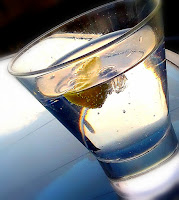Tonic to my Gin
I've recently been experimenting with making my own tonic water. There are any number of online recipes, and I've been working my way through them to see which suits me best. All home-made tonics are made as a flavoured syrup, to which soda water is added at the point of serving. At its most basic, this can be a simple syrup of quinine, citric acid and sugar, very similar to the medicinal tonics that were first added to gin in the seventeenth century. Most online suggestions are more complex than that, using citrus peels, juices, herbs and/or spices to create a more layered experience. Whichever recipe you choose, remember that your drink is always going to contain a goodly dose of quinine, so will taste more bitter than almost every commercial tonic.
If you're going to have a go at making tonic syrup, you'll need two things that are not readily available on the high street: chinchona bark and citric acid. Chinchona is the famed "fever tree" from which quinine is extracted. Quinine has been used for centuries to treat fevers, especially those associated with malaria. It is usually manufactured industrially these days, but extracting it from chinchona bark brings other flavours than the simple bitterness of the quinine. I find its flavour reminiscent of gentian root or turmeric. It is bitter as hell and unmistakeably woody, but I love it. The citric acid brings a sharpness to the drink and helps with the extraction of quinine. You can buy both of these ingredients online or in certain specialist shops. It's important to use chipped bark, not powdered, so you do not extract too much quinine, which can be dangerous.Having tried out a few recipes, I'm in a position to comment on how they mix with different gins. I had expected to find that the complex tonic syrups work best with simple gins, and vice versa. I was wrong. The simplest tonic, flavoured only with chinchona bark and citric acid is bold and punchy, and I find it somewhat overpowers complex gins, masking any nuances of flavour. This kind of tonic works gloriously well, though, with strong, juniper-forward, simpler gins. It's great with generic London dry, or with Tanqueray Export, Beefeater and Plymouth gins.
For more complex gins, I've found that citrus-based tonic syrups work best. It's up to you which fruits you want to use, but lemons and limes seem to be a constant. Pay attention to the method of extracting flavour, as this will make a big difference to the end result. Boiling all the ingredients together will result in a marmalade-like flavour: you are cooking the peels in sugar as you would for marmalade. Cold extraction takes much longer (3 days, rather than 20 minutes) and results in a stronger citrus aroma - full of zing and zest, but with perhaps less depth. Adding the juice of the fruits ups the acidity of the drink and will alter the sweetness, too.Beyond the quinine and the citrus, the range of additional flavour choices is practically endless. Rhubarb is a flavour that works particularly well with gin, as does ginger or blood orange. These will cope equally well with both boiling or cold extraction. More delicate flavours like cucumber, mint or lavender are best treated gently and will reward your patience if you cold steep them for a few days. Many recipes I've seen use allspice berries, peppercorns or salt, and why not? Aim to include at least one of the botanicals you love in your gin. That way, your tonic will always bring that out in your G&T.
 |
| A bag of flavours ready to go in the fridge for a few days. This batch contains clove, allspice and lemongrass, in addition to the chinchona and citrus peels. |
And what about leaving the gin out altogether? You've gone to a lot of trouble to make the perfect tonic, after all. Home made tonics are far more enjoyable on their own than any commercial rival. You may find yourself sipping on one of these drinks as you watch the summer sunsets over the next few months, and I guarantee you won't miss the alcohol.
 |
| Natural quinine gives your drink a pleasant amber hue |






What a really interesting article
ReplyDeleteThank you for commenting, David. I'm pleased you enjoy my blog.
DeleteAbsolutely fascinating. I love how many different flavours you can coax from this and they all sound delicious.
ReplyDelete